Pathophysiology of Diseases: [University Name] Assignment
VerifiedAdded on 2022/12/05
|8
|1620
|358
Report
AI Summary
This report provides a comprehensive overview of the pathophysiology of several diseases, including Migraine, Tension Headache, Pulmonary Embolus, and Iron Deficiency Anemia. For each disease, the report details the underlying mechanisms, the disease process and how it occurs, the signs and symptoms experienced by patients, and the physical assessment findings that can aid in diagnosis. Furthermore, the report outlines the pharmacological recommendations for each condition, providing insight into potential treatment strategies. The report is supported by scholarly citations, ensuring the accuracy and reliability of the information presented. This document is a valuable resource for students studying healthcare and related fields, providing in-depth knowledge of the diseases, their causes, and their management.
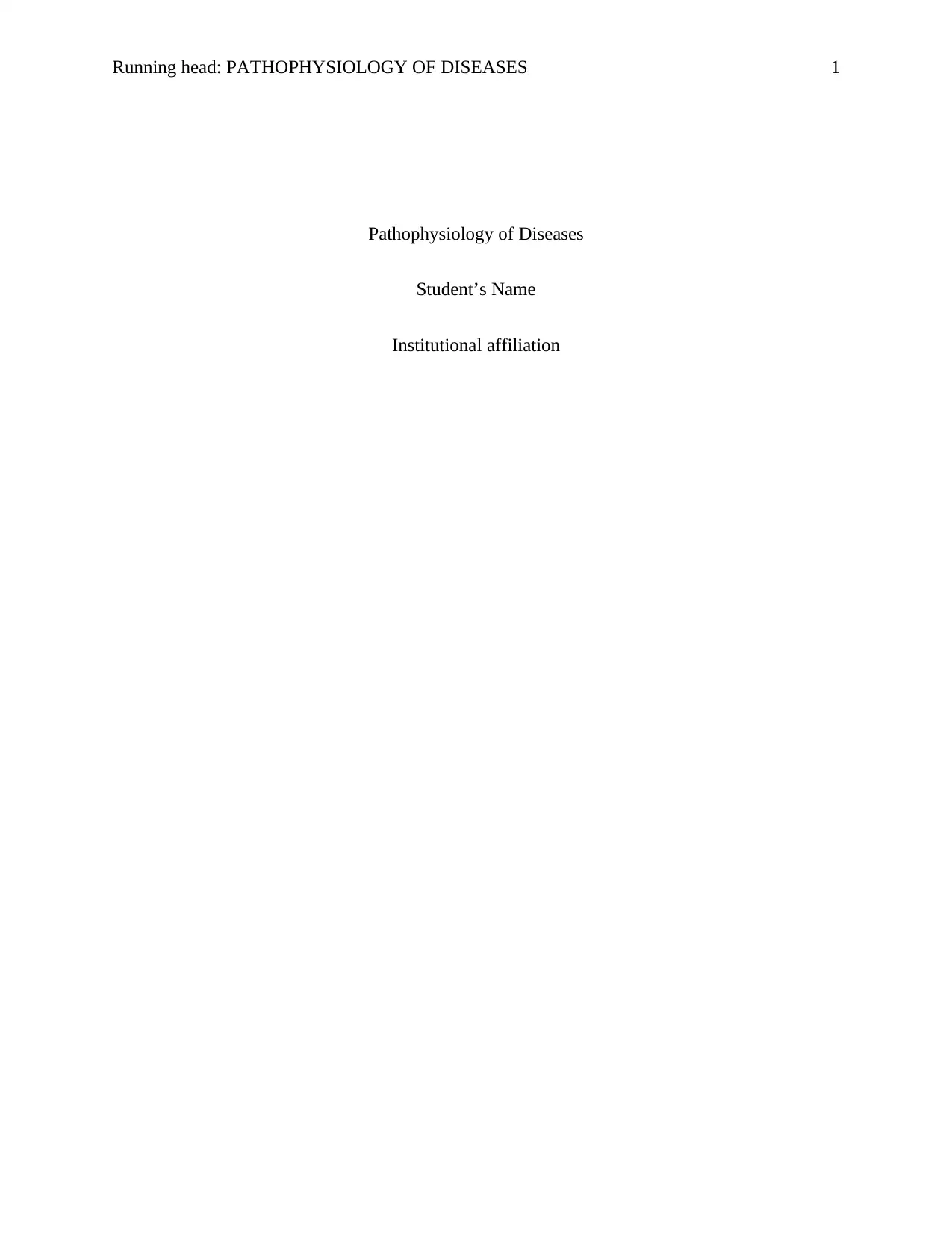
Running head: PATHOPHYSIOLOGY OF DISEASES 1
Pathophysiology of Diseases
Student’s Name
Institutional affiliation
Pathophysiology of Diseases
Student’s Name
Institutional affiliation
Paraphrase This Document
Need a fresh take? Get an instant paraphrase of this document with our AI Paraphraser

PATHOPHYSIOLOGY OF DISEASES 2
Migraine
It is a type of headache often recurring. It causes severe pain especially on one side of the head.
Pathophysiology
The pathophysiology of Migraine is founded upon the physiology and the anatomy of the pain-
producing structures aligned to the cranium (Parikh & Young, 2019). of great interest, is the
inherited nature of this disorder. It has been discovered that most patients suffering from
Migraine also have their close relatives suffering from the disease. According to Lertxundi
(2018), It is also evident that Migraine can be transmitted from parents to their children.
Disease process and how it occurs
Migraine Pain Theory reveals that the pain caused by Migraine occurs because of the numerous
waves of activity engaged by the groups of excitable brain cells. Body chemicals such as
serotonin are triggered causing blood vessels to narrow. Further, when the serotonin or estrogen
levels fluctuate, it results to Migraine. This fluctuations may affect both genders. Fluctuations of
hormone levels in women puts them at a higher risk of suffering from Migraine than in men
(Parikh & Young, 2019). Lowered levels in estrogen often causes constractions in blood vessels
hence making the scalp and facial nerves to become more sensitive to pain.
Signs and symptoms
Migraine will often start during one’s childhood, adolescence and may also get to one’s early
adulthood. It goes through four stages which are prodrome, aura, attack and post-drome. Signs
and symptoms during Prodrome are constipation, abnormal food cravings among others. In Aura,
one will experience vision loss, difficulty in speaking among others. Attack usually lasts between
Migraine
It is a type of headache often recurring. It causes severe pain especially on one side of the head.
Pathophysiology
The pathophysiology of Migraine is founded upon the physiology and the anatomy of the pain-
producing structures aligned to the cranium (Parikh & Young, 2019). of great interest, is the
inherited nature of this disorder. It has been discovered that most patients suffering from
Migraine also have their close relatives suffering from the disease. According to Lertxundi
(2018), It is also evident that Migraine can be transmitted from parents to their children.
Disease process and how it occurs
Migraine Pain Theory reveals that the pain caused by Migraine occurs because of the numerous
waves of activity engaged by the groups of excitable brain cells. Body chemicals such as
serotonin are triggered causing blood vessels to narrow. Further, when the serotonin or estrogen
levels fluctuate, it results to Migraine. This fluctuations may affect both genders. Fluctuations of
hormone levels in women puts them at a higher risk of suffering from Migraine than in men
(Parikh & Young, 2019). Lowered levels in estrogen often causes constractions in blood vessels
hence making the scalp and facial nerves to become more sensitive to pain.
Signs and symptoms
Migraine will often start during one’s childhood, adolescence and may also get to one’s early
adulthood. It goes through four stages which are prodrome, aura, attack and post-drome. Signs
and symptoms during Prodrome are constipation, abnormal food cravings among others. In Aura,
one will experience vision loss, difficulty in speaking among others. Attack usually lasts between
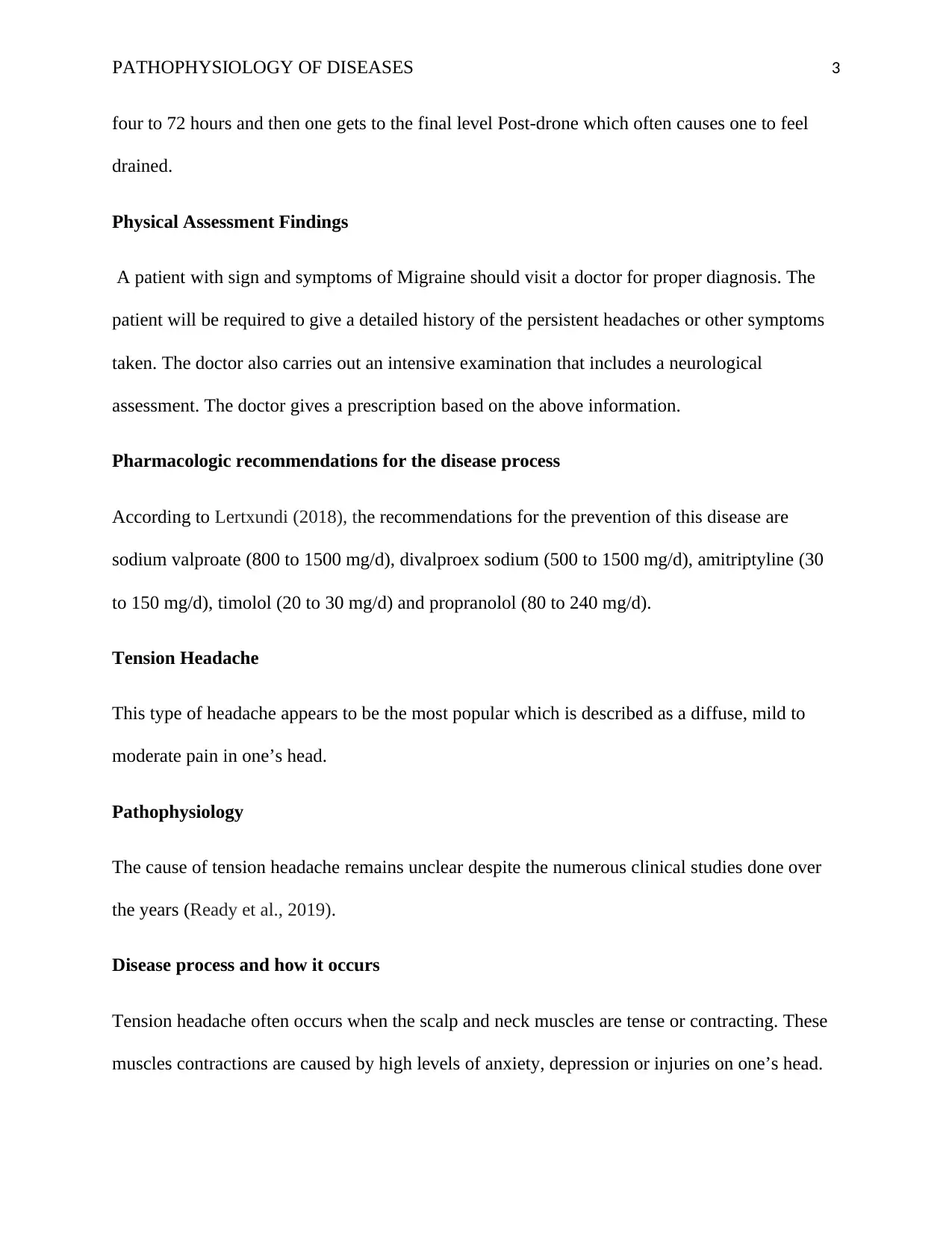
PATHOPHYSIOLOGY OF DISEASES 3
four to 72 hours and then one gets to the final level Post-drone which often causes one to feel
drained.
Physical Assessment Findings
A patient with sign and symptoms of Migraine should visit a doctor for proper diagnosis. The
patient will be required to give a detailed history of the persistent headaches or other symptoms
taken. The doctor also carries out an intensive examination that includes a neurological
assessment. The doctor gives a prescription based on the above information.
Pharmacologic recommendations for the disease process
According to Lertxundi (2018), the recommendations for the prevention of this disease are
sodium valproate (800 to 1500 mg/d), divalproex sodium (500 to 1500 mg/d), amitriptyline (30
to 150 mg/d), timolol (20 to 30 mg/d) and propranolol (80 to 240 mg/d).
Tension Headache
This type of headache appears to be the most popular which is described as a diffuse, mild to
moderate pain in one’s head.
Pathophysiology
The cause of tension headache remains unclear despite the numerous clinical studies done over
the years (Ready et al., 2019).
Disease process and how it occurs
Tension headache often occurs when the scalp and neck muscles are tense or contracting. These
muscles contractions are caused by high levels of anxiety, depression or injuries on one’s head.
four to 72 hours and then one gets to the final level Post-drone which often causes one to feel
drained.
Physical Assessment Findings
A patient with sign and symptoms of Migraine should visit a doctor for proper diagnosis. The
patient will be required to give a detailed history of the persistent headaches or other symptoms
taken. The doctor also carries out an intensive examination that includes a neurological
assessment. The doctor gives a prescription based on the above information.
Pharmacologic recommendations for the disease process
According to Lertxundi (2018), the recommendations for the prevention of this disease are
sodium valproate (800 to 1500 mg/d), divalproex sodium (500 to 1500 mg/d), amitriptyline (30
to 150 mg/d), timolol (20 to 30 mg/d) and propranolol (80 to 240 mg/d).
Tension Headache
This type of headache appears to be the most popular which is described as a diffuse, mild to
moderate pain in one’s head.
Pathophysiology
The cause of tension headache remains unclear despite the numerous clinical studies done over
the years (Ready et al., 2019).
Disease process and how it occurs
Tension headache often occurs when the scalp and neck muscles are tense or contracting. These
muscles contractions are caused by high levels of anxiety, depression or injuries on one’s head.
⊘ This is a preview!⊘
Do you want full access?
Subscribe today to unlock all pages.

Trusted by 1+ million students worldwide
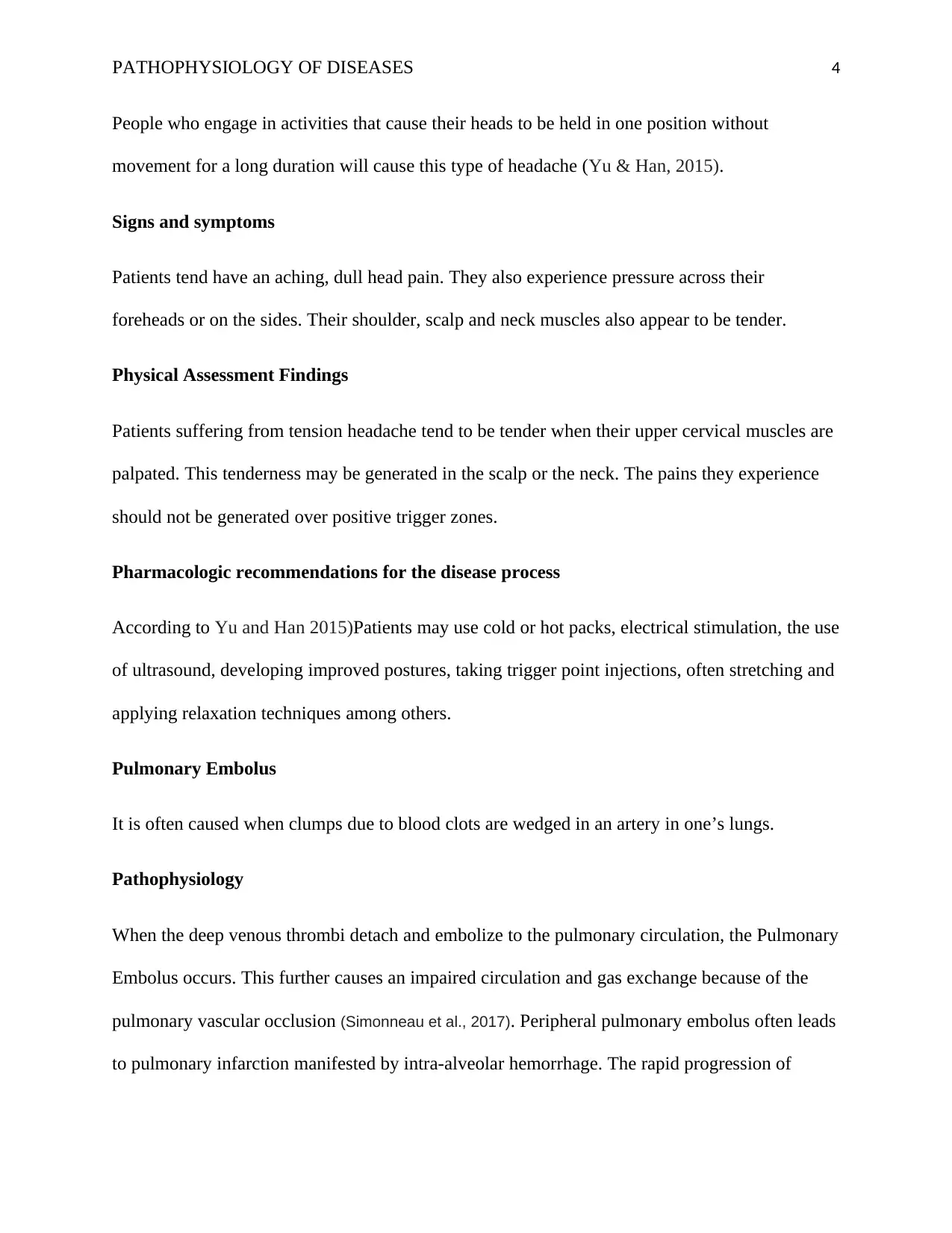
PATHOPHYSIOLOGY OF DISEASES 4
People who engage in activities that cause their heads to be held in one position without
movement for a long duration will cause this type of headache (Yu & Han, 2015).
Signs and symptoms
Patients tend have an aching, dull head pain. They also experience pressure across their
foreheads or on the sides. Their shoulder, scalp and neck muscles also appear to be tender.
Physical Assessment Findings
Patients suffering from tension headache tend to be tender when their upper cervical muscles are
palpated. This tenderness may be generated in the scalp or the neck. The pains they experience
should not be generated over positive trigger zones.
Pharmacologic recommendations for the disease process
According to Yu and Han 2015)Patients may use cold or hot packs, electrical stimulation, the use
of ultrasound, developing improved postures, taking trigger point injections, often stretching and
applying relaxation techniques among others.
Pulmonary Embolus
It is often caused when clumps due to blood clots are wedged in an artery in one’s lungs.
Pathophysiology
When the deep venous thrombi detach and embolize to the pulmonary circulation, the Pulmonary
Embolus occurs. This further causes an impaired circulation and gas exchange because of the
pulmonary vascular occlusion (Simonneau et al., 2017). Peripheral pulmonary embolus often leads
to pulmonary infarction manifested by intra-alveolar hemorrhage. The rapid progression of
People who engage in activities that cause their heads to be held in one position without
movement for a long duration will cause this type of headache (Yu & Han, 2015).
Signs and symptoms
Patients tend have an aching, dull head pain. They also experience pressure across their
foreheads or on the sides. Their shoulder, scalp and neck muscles also appear to be tender.
Physical Assessment Findings
Patients suffering from tension headache tend to be tender when their upper cervical muscles are
palpated. This tenderness may be generated in the scalp or the neck. The pains they experience
should not be generated over positive trigger zones.
Pharmacologic recommendations for the disease process
According to Yu and Han 2015)Patients may use cold or hot packs, electrical stimulation, the use
of ultrasound, developing improved postures, taking trigger point injections, often stretching and
applying relaxation techniques among others.
Pulmonary Embolus
It is often caused when clumps due to blood clots are wedged in an artery in one’s lungs.
Pathophysiology
When the deep venous thrombi detach and embolize to the pulmonary circulation, the Pulmonary
Embolus occurs. This further causes an impaired circulation and gas exchange because of the
pulmonary vascular occlusion (Simonneau et al., 2017). Peripheral pulmonary embolus often leads
to pulmonary infarction manifested by intra-alveolar hemorrhage. The rapid progression of
Paraphrase This Document
Need a fresh take? Get an instant paraphrase of this document with our AI Paraphraser
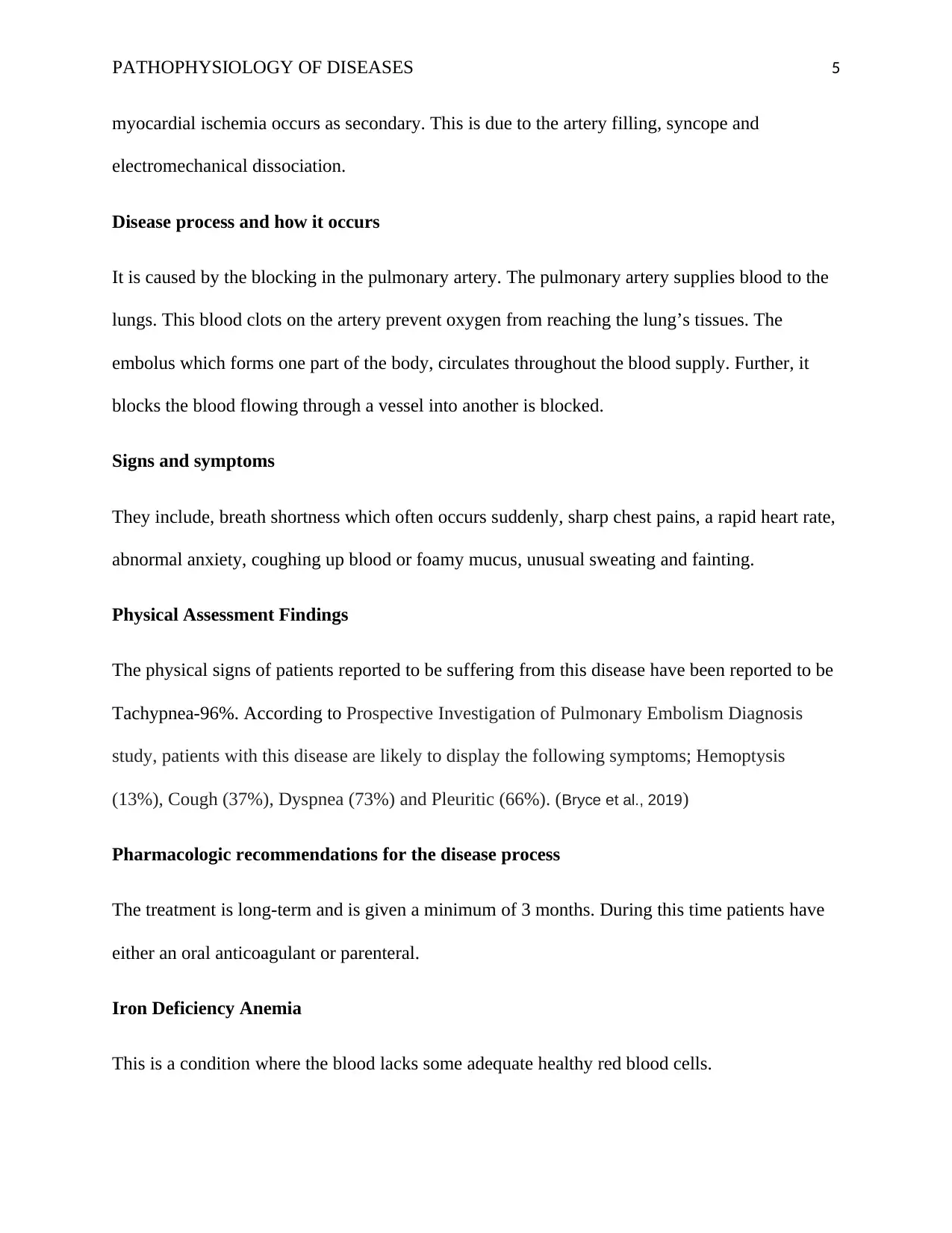
PATHOPHYSIOLOGY OF DISEASES 5
myocardial ischemia occurs as secondary. This is due to the artery filling, syncope and
electromechanical dissociation.
Disease process and how it occurs
It is caused by the blocking in the pulmonary artery. The pulmonary artery supplies blood to the
lungs. This blood clots on the artery prevent oxygen from reaching the lung’s tissues. The
embolus which forms one part of the body, circulates throughout the blood supply. Further, it
blocks the blood flowing through a vessel into another is blocked.
Signs and symptoms
They include, breath shortness which often occurs suddenly, sharp chest pains, a rapid heart rate,
abnormal anxiety, coughing up blood or foamy mucus, unusual sweating and fainting.
Physical Assessment Findings
The physical signs of patients reported to be suffering from this disease have been reported to be
Tachypnea-96%. According to Prospective Investigation of Pulmonary Embolism Diagnosis
study, patients with this disease are likely to display the following symptoms; Hemoptysis
(13%), Cough (37%), Dyspnea (73%) and Pleuritic (66%). (Bryce et al., 2019)
Pharmacologic recommendations for the disease process
The treatment is long-term and is given a minimum of 3 months. During this time patients have
either an oral anticoagulant or parenteral.
Iron Deficiency Anemia
This is a condition where the blood lacks some adequate healthy red blood cells.
myocardial ischemia occurs as secondary. This is due to the artery filling, syncope and
electromechanical dissociation.
Disease process and how it occurs
It is caused by the blocking in the pulmonary artery. The pulmonary artery supplies blood to the
lungs. This blood clots on the artery prevent oxygen from reaching the lung’s tissues. The
embolus which forms one part of the body, circulates throughout the blood supply. Further, it
blocks the blood flowing through a vessel into another is blocked.
Signs and symptoms
They include, breath shortness which often occurs suddenly, sharp chest pains, a rapid heart rate,
abnormal anxiety, coughing up blood or foamy mucus, unusual sweating and fainting.
Physical Assessment Findings
The physical signs of patients reported to be suffering from this disease have been reported to be
Tachypnea-96%. According to Prospective Investigation of Pulmonary Embolism Diagnosis
study, patients with this disease are likely to display the following symptoms; Hemoptysis
(13%), Cough (37%), Dyspnea (73%) and Pleuritic (66%). (Bryce et al., 2019)
Pharmacologic recommendations for the disease process
The treatment is long-term and is given a minimum of 3 months. During this time patients have
either an oral anticoagulant or parenteral.
Iron Deficiency Anemia
This is a condition where the blood lacks some adequate healthy red blood cells.

PATHOPHYSIOLOGY OF DISEASES 6
Pathophysiology
Iron deficiency often occurs due occult gastrointestinal bleeding. Iron is very essential in the
production of hemoglobin (Lopez et al., 2016). Its depletion may be because of blood loss,
impaired absorption, a decreased intake of blood or an increased demand in the body.
Disease process and how it occurs
Just as the name suggests, iron deficiency anemia is caused due to insufficient iron in the body.
This brings a low production of substances in red blood cells that helps them in carrying oxygen.
This disease often leaves the patient very tired and short of breath.
Signs and symptoms
The patient may show signs of extreme fatigue, have a pale skin, fast heartbeat, chest pains,
dizziness, headaches, cold hands and feet, soreness of the tongue and very brittle nails.
Physical Assessment Findings
Most patients suffering from this disease have their physical findings showing glossitis, spooning
of nails and angular stomatitis (Murawska et al., 2016). They may also display dyspnea, exercise
intolerance, dysphagia, growth impairment and behavioral issues.
Pharmacologic recommendations for the disease process
Oral administration of the ferrous iron salts.
Pathophysiology
Iron deficiency often occurs due occult gastrointestinal bleeding. Iron is very essential in the
production of hemoglobin (Lopez et al., 2016). Its depletion may be because of blood loss,
impaired absorption, a decreased intake of blood or an increased demand in the body.
Disease process and how it occurs
Just as the name suggests, iron deficiency anemia is caused due to insufficient iron in the body.
This brings a low production of substances in red blood cells that helps them in carrying oxygen.
This disease often leaves the patient very tired and short of breath.
Signs and symptoms
The patient may show signs of extreme fatigue, have a pale skin, fast heartbeat, chest pains,
dizziness, headaches, cold hands and feet, soreness of the tongue and very brittle nails.
Physical Assessment Findings
Most patients suffering from this disease have their physical findings showing glossitis, spooning
of nails and angular stomatitis (Murawska et al., 2016). They may also display dyspnea, exercise
intolerance, dysphagia, growth impairment and behavioral issues.
Pharmacologic recommendations for the disease process
Oral administration of the ferrous iron salts.
⊘ This is a preview!⊘
Do you want full access?
Subscribe today to unlock all pages.

Trusted by 1+ million students worldwide
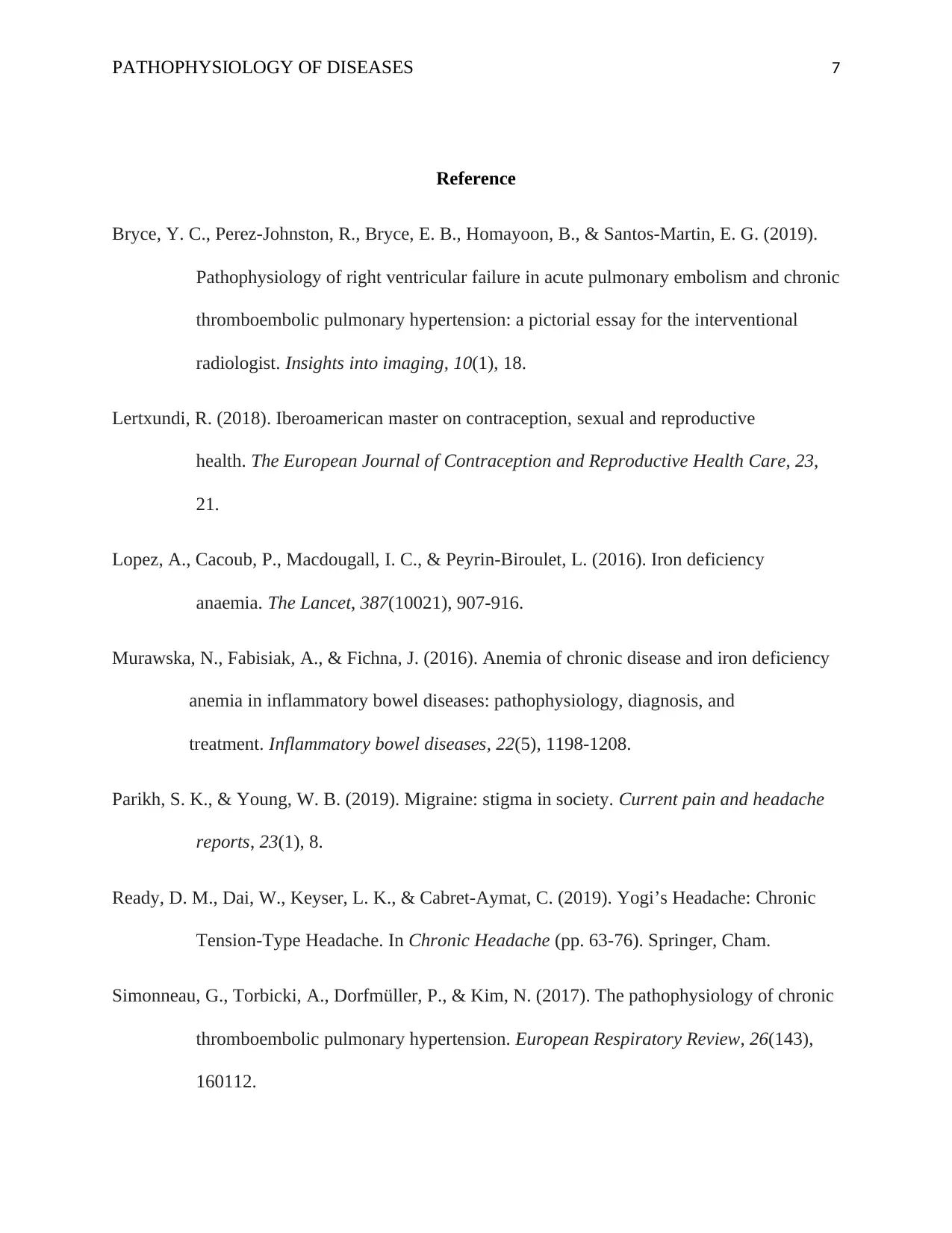
PATHOPHYSIOLOGY OF DISEASES 7
Reference
Bryce, Y. C., Perez-Johnston, R., Bryce, E. B., Homayoon, B., & Santos-Martin, E. G. (2019).
Pathophysiology of right ventricular failure in acute pulmonary embolism and chronic
thromboembolic pulmonary hypertension: a pictorial essay for the interventional
radiologist. Insights into imaging, 10(1), 18.
Lertxundi, R. (2018). Iberoamerican master on contraception, sexual and reproductive
health. The European Journal of Contraception and Reproductive Health Care, 23,
21.
Lopez, A., Cacoub, P., Macdougall, I. C., & Peyrin-Biroulet, L. (2016). Iron deficiency
anaemia. The Lancet, 387(10021), 907-916.
Murawska, N., Fabisiak, A., & Fichna, J. (2016). Anemia of chronic disease and iron deficiency
anemia in inflammatory bowel diseases: pathophysiology, diagnosis, and
treatment. Inflammatory bowel diseases, 22(5), 1198-1208.
Parikh, S. K., & Young, W. B. (2019). Migraine: stigma in society. Current pain and headache
reports, 23(1), 8.
Ready, D. M., Dai, W., Keyser, L. K., & Cabret-Aymat, C. (2019). Yogi’s Headache: Chronic
Tension-Type Headache. In Chronic Headache (pp. 63-76). Springer, Cham.
Simonneau, G., Torbicki, A., Dorfmüller, P., & Kim, N. (2017). The pathophysiology of chronic
thromboembolic pulmonary hypertension. European Respiratory Review, 26(143),
160112.
Reference
Bryce, Y. C., Perez-Johnston, R., Bryce, E. B., Homayoon, B., & Santos-Martin, E. G. (2019).
Pathophysiology of right ventricular failure in acute pulmonary embolism and chronic
thromboembolic pulmonary hypertension: a pictorial essay for the interventional
radiologist. Insights into imaging, 10(1), 18.
Lertxundi, R. (2018). Iberoamerican master on contraception, sexual and reproductive
health. The European Journal of Contraception and Reproductive Health Care, 23,
21.
Lopez, A., Cacoub, P., Macdougall, I. C., & Peyrin-Biroulet, L. (2016). Iron deficiency
anaemia. The Lancet, 387(10021), 907-916.
Murawska, N., Fabisiak, A., & Fichna, J. (2016). Anemia of chronic disease and iron deficiency
anemia in inflammatory bowel diseases: pathophysiology, diagnosis, and
treatment. Inflammatory bowel diseases, 22(5), 1198-1208.
Parikh, S. K., & Young, W. B. (2019). Migraine: stigma in society. Current pain and headache
reports, 23(1), 8.
Ready, D. M., Dai, W., Keyser, L. K., & Cabret-Aymat, C. (2019). Yogi’s Headache: Chronic
Tension-Type Headache. In Chronic Headache (pp. 63-76). Springer, Cham.
Simonneau, G., Torbicki, A., Dorfmüller, P., & Kim, N. (2017). The pathophysiology of chronic
thromboembolic pulmonary hypertension. European Respiratory Review, 26(143),
160112.
Paraphrase This Document
Need a fresh take? Get an instant paraphrase of this document with our AI Paraphraser

PATHOPHYSIOLOGY OF DISEASES 8
Yu, S., & Han, X. (2015). Update of chronic tension-type headache. Current pain and headache
reports, 19(1), 469.
Yu, S., & Han, X. (2015). Update of chronic tension-type headache. Current pain and headache
reports, 19(1), 469.
1 out of 8
Your All-in-One AI-Powered Toolkit for Academic Success.
+13062052269
info@desklib.com
Available 24*7 on WhatsApp / Email
![[object Object]](/_next/static/media/star-bottom.7253800d.svg)
Unlock your academic potential
Copyright © 2020–2025 A2Z Services. All Rights Reserved. Developed and managed by ZUCOL.